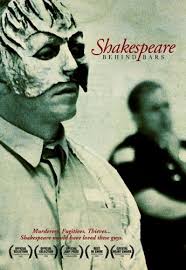
SHAKESPEARE BEHIND BARS
US, 2005, 93 minutes, Colour.
Directed by Hank Rogerson.
This is a documentary well worth seeing. It focuses on prisoners, education, a contribution to rehabilitation, a variation on restorative justice.
In the website of the program, giving the background to this prison work:
Founded in 1995, Shakespeare Behind Bars is one of the longest running, continuously operating, art, theatre, Shakespeare, and original writing prison programs in the US.
Shakespeare Behind Bars currently serves 200 incarcerated adults and juveniles in in twelve SBB programs in three Kentucky adult prisons – Luther Luckett Correctional Complex, Northpoint Training Center, & Southeast State Correctional Complex (virtual program); five Kentucky juvenile detention centers – Breathitt County Juvenile Detention Center Alternative School; Fayette Regional Juvenile Detention Center, Frenchburg Youth Home; Jackson County Youth Center; Warren County Regional Juvenile Detention Center; one Illinois juvenile detention center – Illinois Youth Center – Chicago; two virtual program for returned citizens – Shax BEYOND Bars and Shax BEYOND Bars Writer’s Circle; and one touring returned citizen memoire program – Othello’s Tribunal.
Additionally, Philomath Films and Shakespeare Behind Bars are filming a second documentary – Shakespeare BEYOND Bars.
Since 1995, Shakespeare Behind Bars has offered theatrical encounters with personal and social issues to incarcerated, post-incarcerated, and at-risk communities, allowing them to develop life skills that will ensure their successful integration into society. The youth and adults we serve experience a powerful personal transformation as a result, building life skills, emotional intelligence and coping strategies essential to successfully re-integrate into society.
In this film, the prisoners are auditioning for, training for, rehearsing, performing Shakespeare’s The Tempest. They have a performing space, a director coming from outside who has experience in working with prisoners, a talent for drama, for training in rehearsing, for affirming the performances.
In the meantime, and throughout the film, there are quite a number of scenes of the prison, its environment, the landscapes outside, the buildings inside, the vast spaces.
Quite a number of the prisoners are interested in performance, learn their lines, are coached in recitation, a strong emphasis on individual words and their meaning as well as the rhythms, extensive scenes from The Tempest.
And, the prisoners themselves. Most present themselves initially as friendly. The Dir is able to draw from them their own stories, the crimes, their sentences, possibilities for parole or not. And there are their regrets. So many of the crimes are physical violence against women. In performing and in giving interviews, there are some opportunities for the prisoners to acknowledge the truth about themselves and the consequences of their actions.
The audience gets to know some of the performers very well as well as commentary by the director.
The film offers an opportunity for the wider audience to understand something of this kind of prison rehabilitation and education, an opportunity to listen to the stories of the prisoners, to appreciate the impact of the long sentences and the desire for parole, and all in the context Shakespeare’s characters, his final play, and the social issues that the play brings up, the character of Prospero, Miranda, the rivalries, the politics, Caliban, Ariel and the touch of the supernatural.